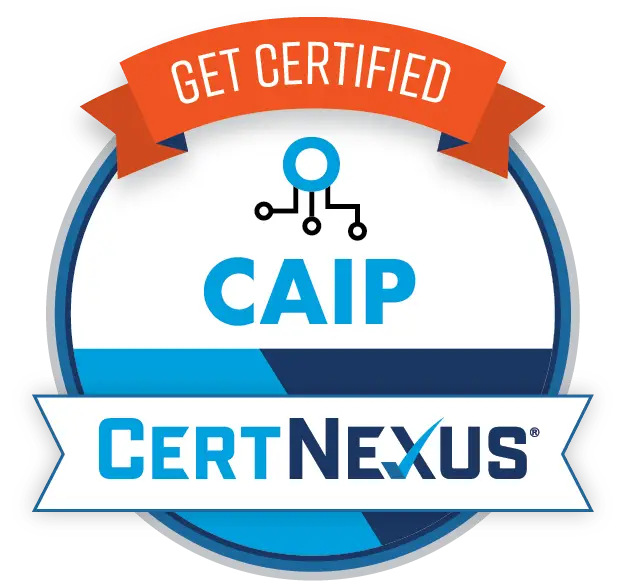
Certified Artificial Intelligence Practitioner (CAIP)
The Certified Artificial Intelligence Practitioner™ (CAIP) shows you how to apply various approaches and algorithms to solve business problems through artificial intelligence (AI) and machine learning (ML), follow a methodical workflow to develop sound solutions, use open source, off-the-shelf tools to develop, test, and deploy those solutions, and ensure that they protect the privacy of users.
AI and ML have become an essential part of the toolset for many organizations. When used effectively, these tools provide actionable insights that drive critical decisions and enable organizations to create exciting, new, and innovative products and services.
Training at a glance
Level
Intermediate
Duration
5 Days
Experience
2 years: Programming
Average Salary
$116,000
Labs
Yes
Level
Intermediate
Duration
5 Days
Experience
2 years: Programming
Average Salary
$116,000
Labs
Yes
Training Details
In this course, you will implement AI techniques in order to solve business problems.
You will:
- Specify a general approach to solve a given business problem that uses applied AI and ML
- Collect and refine a dataset to prepare it for training and testing
- Train and tune a machine learning model
- Finalize a machine learning model and present the results to the appropriate audience
- Build linear regression models
- Build classification models
- Build clustering models
- Build decision trees and random forests
- Build support-vector machines (SVMs)
- Build artificial neural networks (ANNs)
- Promote data privacy and ethical practices within AI and ML projects
- Topic A: Identify AI and ML Solutions for Business Problems
- Topic B: Formulate a Machine Learning Problem
- Topic C: Select Approaches to Machine Learning
Lesson 2: Preparing Data
- Topic A: Collect Data
- Topic B: Transform Data
- Topic C: Engineer Features
- Topic D: Work with Unstructured Data
Lesson 3: Training, Evaluating, and Tuning a Machine Learning Model
- Topic A: Train a Machine Learning Model
- Topic B: Evaluate and Tune a Machine Learning Model
Lesson 4: Building Linear Regression Models
- Topic A: Build Regression Models Using Linear Algebra
- Topic B: Build Regularized Linear Regression Models
- Topic C: Build Iterative Linear Regression Models
Lesson 5: Building Forecasting Models
- Topic A: Build Univariate Time Series Models
- Topic B: Build Multivariate Time Series Models
Lesson 6: Building Classification Models Using Logistic Regression and k-Nearest Neighbor
- Topic A: Train Binary Classification Models Using Logistic Regression
- Topic B: Train Binary Classification Models Using k-Nearest Neighbor
- Topic C: Train Multi-Class Classification Models
- Topic D: Evaluate Classification Models
- Topic E: Tune Classification Models
Lesson 7: Building Clustering Models
- Topic A: Build k-Means Clustering Models
- Topic B: Build Hierarchical Clustering Models
Lesson 8: Building Decision Trees and Random Forests
- Topic A: Build Decision Tree Models
- Topic B: Build Random Forest Models
Lesson 9: Building Support-Vector Machines
- Topic A: Build SVM Models for Classification
- Topic B: Build SVM Models for Regression
Lesson 10: Building Artificial Neural Networks
- Topic A: Build Multi-Layer Perceptrons (MLP)
- Topic B: Build Convolutional Neural Networks (CNN)
- Topic C: Build Recurrent Neural Networks (RNN)
Lesson 11: Operationalizing Machine Learning Models
- Topic A: Deploy Machine Learning Models
- Topic B: Automate the Machine Learning Process with MLOps
- Topic C: Integrate Models into Machine Learning Systems
Lesson 12: Maintaining Machine Learning Operations
- Topic A: Secure Machine Learning Pipelines
- Topic B: Maintain Models in Production
Appendix A: Mapping Course Content to CertNexus® Certified Artificial Intelligence (AI) Practitioner (Exam AIP-210) Appendix B: Datasets Used in This Course
The skills covered in this course converge on four areas—software development, IT operations, applied math and statistics, and business analysis. Target students for this course should be looking to build upon their knowledge of the data science process so that they can apply AI systems, particularly machine learning models, to business problems.
So the target student is likely a data science practitioner, software developer, or business analyst looking to expand their knowledge of machine learning algorithms and how they can help create intelligent decision making products that bring value to the business.
A typical student in this course should have several years of experience with computing technology, including some aptitude in computer programming.
This course is also designed to assist students in preparing for the CertNexus® Certified Artificial Intelligence (AI) Practitioner (Exam AIP-210) certification.
To ensure your success in this course, you should have at least a high-level understanding of fundamental AI concepts, including, but not limited to: machine learning, supervised learning, unsupervised learning, artificial neural networks, computer vision, and natural language processing. You can obtain this level of knowledge by taking the CertNexus AIBIZ™ (Exam AIZ-110) course.
You should also have experience working with databases and a high-level programming language such as Python, Java, or C/C++. You can obtain this level of skills and knowledge by taking the following
- Logical Operations or comparable course:
Database Design: A Modern Approach - Python® Programming: Introduction
- Python® Programming: Advanced
Upcoming Classes
We Offer More Than Just CertNexus Training
Our successful training results keep our corporate and military clients returning.
Strategic Planning & Project Management
From Lean Six Sigma to Project Management Institute Project Management Professional, Agile and SCRUM, we offer the best-in-class strategic planning and project management training available. Work closely with our seasoned multi-decade project managers.
IT & Cybersecurity
ATA is the leading OffSec and Hack the Box US training provider, and a CompTIA and EC-Council award-winning training partner. We offer the best offensive and defensive cyber training to keep your team ahead of the technology skills curve.
Leadership & Management
Let us teach your team the high-level traits and micro-level tools & strategies of effective 21st-century leadership. Empower your team to play to each others’ strengths, inspire others and build a culture that values communication, authenticity, and community.
